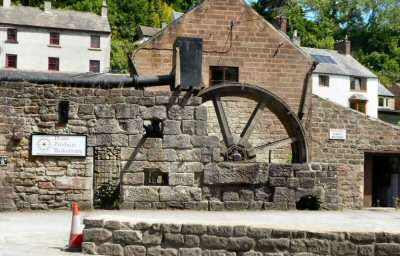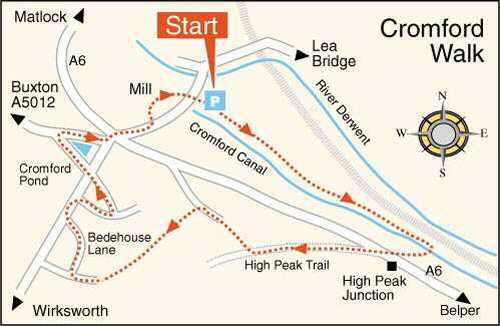CROMFORD AND HIGH PEAK JUNCTION WALK
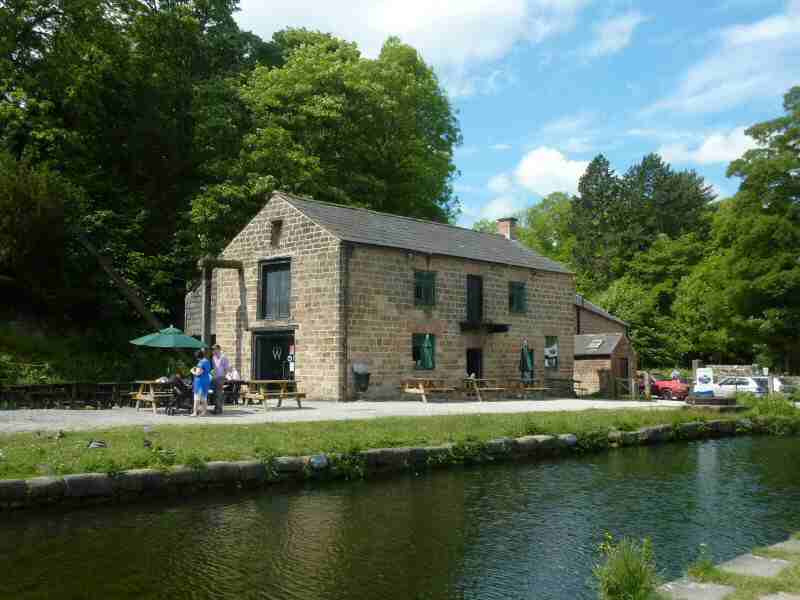
THE WALK
Beautiful scenery, abundant wildlife, and world-renowned heritage make the Cromford and High Peak Junction Walk very special. In 2001, the Derwent Valley was awarded World Heritage Status.
From Cromford Wharf, where there are several interesting canal buildings, follow the towpath for one and a quarter miles. In summer, large numbers of butterflies and dragonflies can be seen, and numerous species of birdlife can be identified overhead.
On reaching High Peak Junction, there is a collection of interesting old railway buildings to inspect before heading up High Peak Trail. After a short distance, you leave the trail and begin the return journey to Cromford, often called the ‘Cradle of the Industrial Revolution’.
Route Point 1 – The construction of the Cromford Canal was completed in late 1794 to improve the movement of heavy goods in and out of Cromford. It linked up with the Erewash Canal at Langley Mill, which ran into the River Trent. This connected with Derby and Nottingham and, beyond that, with Liverpool and Manchester by the Trent and Mersey Canal.
Point 2 – The High Peak Junction Workshops date from the earliest days of the railway, built between 1826 and 1830. They remain virtually unchanged since then, with tools, railway artefacts, a joiner’s bench, a forge, and bellows. The cast-iron, fish-bellied rails on either side of the inspection pit could be the oldest length of railway line in the world still in its original position. A leaflet has been produced to enable visitors to identify the large array of memorabilia on display.
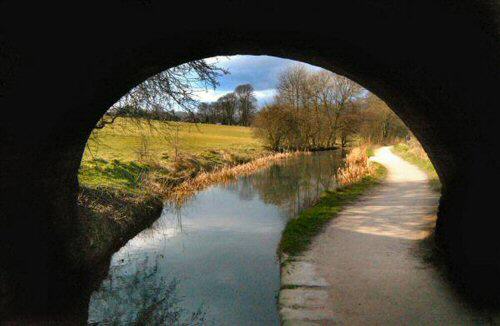
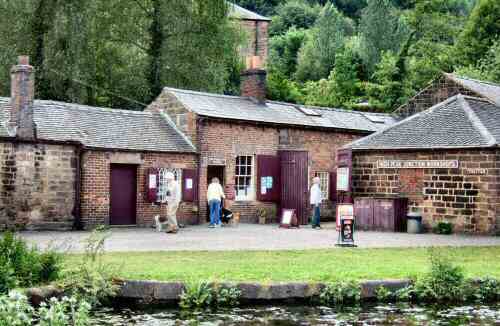
Point 3 – Originally, High Peak Trail was a railway line, considered an engineering masterpiece. It has attracted the interest of railway enthusiasts from all over the world. The line linked High Peak Junction, 277 feet above sea level, with Whaley Bridge, 570 feet. In the middle, it rose to over 1,000 feet at Ladmanlow.
Point 6—Richard Arkwright built the houses in North Street between 1771 and 1776 to house handloom weavers. They were of good quality to attract skilled workers to what was then a remote part of Derbyshire. They represented the first planned industrial housing in the county and, according to some historians, the first in the world. Large windows were installed on the top floors to provide maximum light for workers to work from home. The street contains some of the finest examples of Industrial Archaeology in England.
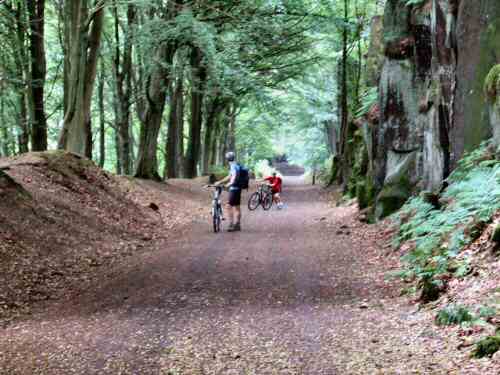
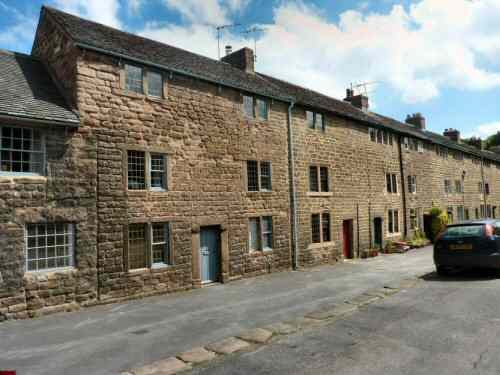
Point 8 – When Arkwright arrived, Cromford was little more than a tiny hamlet. He had to attract workers; to do this, he built most of the village, much as we know it today. With the houses he built all the facilities necessary for village life in those days, even setting up a market. Nor did he forget his past as a barber, building a barber’s shop, where the popular Tor Café is now situated. He built the Greyhound Hotel; at the rear is the Greyhound Pond. Together with a series of ponds along the Bonsall Brook, the purpose of its creation in the 18th century, as industrial production expanded, was purely functional – to ensure a constant head of water for the wheels of the mills to drive the machinery.
Point 10 – Cromford Mills Centre is the home of Richard Arkwright’s first mill complex, where the modern factory system was born. It is internationally recognised as a UNESCO World Heritage Site and a great place to visit, with many visitor attractions, shops, cafes, exhibitions, and guided tours. Arkwright was generally regarded as a generous employer at a time when many of his contemporaries had no interest in their workers and families. His factories were much cleaner and better maintained than was usual in those days. The houses he erected for his employees were well-built and described as models of comfort and neatness. As a result of all his efforts, the Victorians considered him the ‘the father of the factory system’. Arkwright became very rich and famous, and in 1786, he was knighted. He was the first commoner ever to be knighted, and as a result of his achievements, Britain was transformed into the workshop of the world.
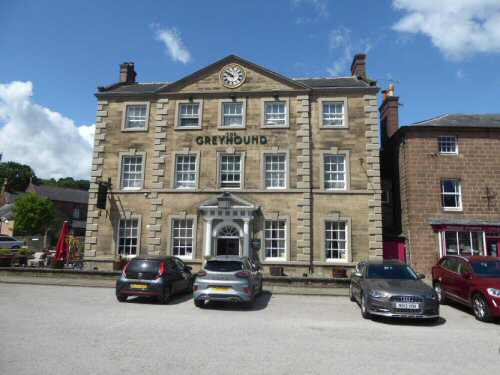
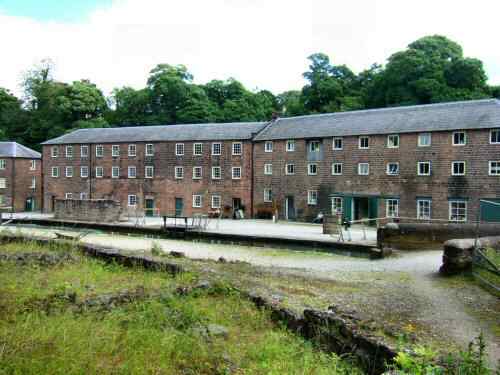
WALK DETAILS
Length: 3.5 miles.
Location: On the A6 two miles south of Matlock. Leave the A6 at the traffic lights at Cromford, turning right for Arkwright’s Mill. Cromford Wharf Car Park is on the right, just past Arkwright’s Mill entrance.
Terrain: Mostly flat with one incline and descent. Muddy in places.
THE ROUTE
1. The walk starts at Cromford Wharf Car Park, going to the left along the towpath of the Cromford Canal.
2. High Peak Junction is reached in one and a quarter miles, where you cross the canal and walk between the old railway buildings.
3. Ascend the High Peak Trail and turn left after one-third of a mile, where you see a footpath signed for ‘Alderwasley’. A few yards later, go left again through the tunnel, which takes you back under the trail you just walked over.
4. Continue down the lane towards Cromford. Immediately after reaching a row of houses on your right, just before Castle View Drive, take the footpath sign on the left.
5. Follow the stiled path, keeping close to the fence. Pass to the left of a derelict barn to reach a farm lane. Go up the lane to join Barnwell Lane on the right.
6. Take the first right turn down Bedehouse Lane and follow it to the main road, turning right and then right again into North Street.
7. At the end of the street, opposite the school, the path leads off to the left and, within 20 yards, goes through a gap in the wall past a very large circular sluice to reach the main road again.
8. Cross the road and go up Water Lane (A619), turning right just past the waterwheel, following the road round as it bends to the right down Scarthin, soon to rejoin the main road by the Greyhound Hotel
9. Turn left, walk down to the traffic lights to cross the A6 and continue down Mill Lane.
10. Go left to visit the Arkwright Mill Centre, leaving through the Mill Car Park, crossing the road, and turning left back to the start of the walk.
Cromford
